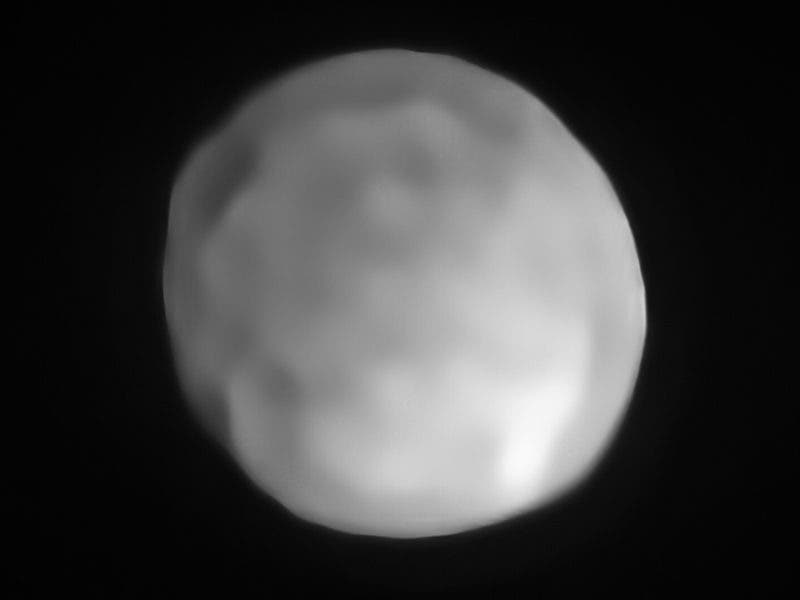Around 2 billion years ago, two large rock bodies hit each other in the main asteroid belt, a region between the orbits of Mars and Jupiter populated by fragments of rocks of various sizes. The impactor, with a size ranging from 75 to 150 kilometers in diameter, hit a body at least 4 times larger. Astronomers have known about this impact for a long time because it created a whole family of asteroids in the main asteroid belt, formed by the celestial body Hygiea and almost 7,000 smaller asteroids that have similar orbits.

Hygiea itself has been considered an asteroid since it was discovered in 1849 by Italian astronomer Annibale de Gasparis. With a diameter just over 430 kilometers, it is the fourth-largest object in the main asteroid belt. New observations obtained with the Very Large Telescope (VLT), located in Chile and operated by the European Southern Observatory, have revealed that Hygiea is also round.
Determining the shape of Hygiea doesn’t have any practical implications for its orbit or behavior, but it’s enough to propel Hygiea from asteroid to dwarf planet, according to current scientific classifications.
There are four conditions that solar system objects must meet to be classified as dwarf planets: They must orbit the Sun, not be a satellite orbiting another body, not be massive enough to clear their orbit from other objects, and have a round shape due to their own gravity.
Fulfilling all the requirements makes Hygiea the smallest dwarf planet in the solar system, as researchers report in Nature Astronomy, taking the position from Ceres, which has a diameter of 950 kilometers. Pluto is the largest dwarf planet, with a diameter of 2,400 kilometers. For reference, our own Moon has a diameter of 3,474 kilometers, larger than any of the dwarf planets.
Observations with SPHERE
These new observations benefited from a new instrument, the Spectro-Polarimetric High-contrast Exoplanet Research instrument (SPHERE), installed in 2014 on one of the four 8.2-meter individual telescopes that form the VLT. SPHERE was designed to detect and study new giant exoplanets orbiting nearby stars, but it can also be used to observe small objects within our solar system with unprecedented resolution, as this study has shown.
“The revolution with SPHERE is that it works at the refraction limit of the telescope,” said Pierre Vernazza, an astronomer at the Laboratoire d’Astrophysique de Marseille in France and first author of the new study. “The combo of SPHERE and VLT is currently the most powerful imaging system in the world. Objects that were just a few pixels across before become really visible, and we can see craters that are just 30 kilometers in size and do geology from the ground thanks to this improvement.”
The team also showed that Hygiea rotates with a period of 13.8 hours, half the previously accepted value.
“It is solid work showing off amazing capabilities from Earth that we previously thought could only be possible from space,” said Richard Binzel, a planetary scientist at the Massachusetts Institute of Technology who wasn’t involved in the study. “It is a combination of large telescope aperture, clever optical design, and high-speed computing to cancel out the blurring effects of Earth’s atmosphere, much like how noise-canceling headphones deliver a clear sound in the hubbub of an airport.”
A Smooth Surface Reveals a Violent Past
What really came as a surprise, Vernazza said, is that Hygiea’s surface is smooth, lacking signs of large impacts. Researchers were expecting to find some sort of a large impact basin, as is the case on the asteroid Vesta, which bears the mark of a massive impact on its south pole. Vesta also has its own family of asteroids, albeit smaller than Hygiea’s.
What Hygiea’s smooth surface reveals, according to the new study, is that the impact that created Hygiea was so powerful that it completely shattered its parent body. The fragments then coalesced again, assuming a round shape, and a fraction of the mass was ejected to form Hygiea’s asteroid family.
“Most of the mass was reaccreted to form Hygiea, and the reaccreting body behaves as a fluid during a few hours,” Vernazza said, “and that’s what allowed it to acquire a shape that is roughly spherical.”
To test this hypothesis, the team created a series of computer simulations that show that the most likely scenario involved a fast-traveling impactor between 75 and 150 kilometers in diameter and that the whole process probably took just a few hours to complete.
As telescopes keep improving and astronomers are able to observe more distant objects, the list of dwarf planets is sure to grow. “There are a lot of candidates among trans-Neptunian objects, and as far as we know, there are more than a hundred bodies with diameters above 400 kilometers, and for sure most of these bodies will be roughly spherical,” Vernazza said. To be able to obtain direct imaging observations of these bodies, equivalent to what the VLT has done with Hygiea, astronomers will have to wait until the next generation of 30- to 40-meter telescopes is available at some point within the next decade.
“We’re still in the reconnaissance phase of exploring our solar system,” Binzel said.
—Javier Barbuzano (@javibarbuzano), Freelance Science Journalist
This article was originally published on Eos and has been republished here under a CC BY-NC-ND 3.0 license.


